Zoom H4essential Handy Recorder with 4 tracks, 120 dB SPL 90º XY Mics and 32-bit float recording
ZoomSS-10012068
Afsendes indenfor 7-14 arbejdsdage
1.500 DKK
Same as DA-6400 wit two power supply circuits built-in to allow redundant power from another AC circuit.
The Tascam DA-6400 is a universal recording system for up to 64 audio tracks received from a Digital Audio Workstation or live mixing console. The recorder can be used with a variety of interface boards like MADI, Dante, DigiLink, AVB or AES/EBU to integrate flawlessly into virtually any environment. Moreover, Tascam plans to maintain the recorder as a living system by adapting it continuously to new interfaces and systems according to the needs of users.
The Tascam DA-6400 uses a special real-time operating system and highly reliable SSD drives for storage. A model with rundant power supply is also available (DA-6400dp).

The DA-6400 uses an embedded operating system for quick startup and simple operation. Stable recording is possible when using high sampling rates with large amounts of data transmission. Furthermore, files are saved approximately every 20 seconds during recording, so file losses due to unexpected power supply interruptions are kept to a minimum.
PCM recording/playback from 48 kHz to 96 kHz maximum is supported for compatibility with existing recording studio systems, PA systems and other recording situations where high sampling rates are being utilized.
Note: 32 channels are supported at 96 kHz/24-bit resolution.

The DA-6400 uses solid-state drives (SSD), which have excellent vibration and environmental resistance and offer simple, maintenance-free operation. It includes a Tascam SSD designed and thoroughly tested using DA-6400 units. Component parts, including IC control elements, are carefully selected and constantly tested lot by lot in cooperation with the parts manufacturers to maintain quality specifications.
By installing SSDs into removable AK-CC25 storage cases and using the swappable bay in the DA-6400 unit, it is easy to switch and use multiple drives. Since the DA-6400 is hot-swappable, it is possible to remove and load SSDs stored in AK-CC25 cases even when the power is on, making rapid switching of media possible. SSDs stored in AK-CC25 cases can be connected to computers by USB and used as external drives.
Note: One AK-CC25 and one TASCAM SSD are included with each DA-6400/DA-6400dp unit. Additional cases and drives can also be purchased separately.
Because the clock generator can influence digital signal quality, the DA-6400 employs a temperature-compensated crystal oscillator (TCXO) that boasts a high precision of ±1 ppm (0.048 Hz at 48 kHz).
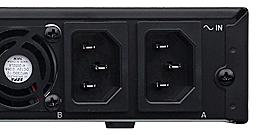
In addition to the DA-6400 standard model, the lineup also includes the DA-6400dp which has two power supply circuits built-in to allow redundant power from another AC circuit. This provides failsafe operation in case AC power is interrupted on one of the circuits.
A single DA-6400 can record and play back up to 64 channels but requires only a small amount of space for installation due to its compact 1U design.
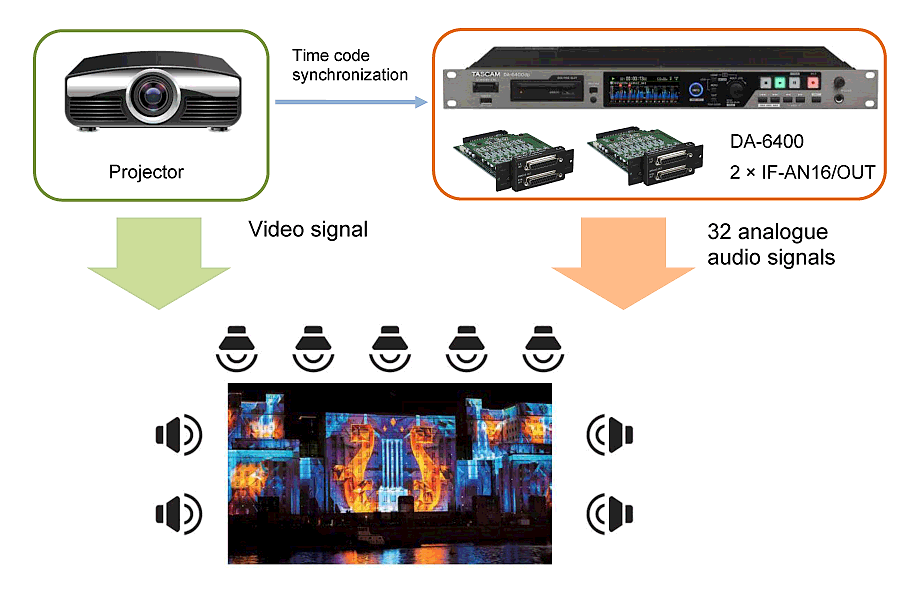
The DA-6400 is a perfect solid-state, compact playback system for theatres, theme parks, and similar venues. By fitting two IF-AN16/OUT analogue output cards, the DA-6400 can supply up to 32 different playback signals for surround sound and impressive special effects. For audio-visual presentations in event and amusement parks the recorder can also synchronise the projector’s video signal to the audio signal.
The playlist function available since firmware v2.00 makes it possible to assign takes to a list in the order you want, change playback order, and nondestructively set playback ranges of every audio entry without affecting the audio files. In addition, loading and writing of JPPA flash start playlist files is supported. After a take from a playlist ends, when Auto Ready mode is enabled, the unit automatically jumps to and pauses at the beginning of the next starting point.

The theatre play function introduced with firmware v2.00 allows marks to be set for playback starting and ending points on each take. This makes it possible to trigger marked playback ranges of multiple takes in order. In this mode, the unit enters playback standby at the first mark and starts playback when a play trigger is received. When the end of the range is reached, the unit stops playback automatically, locates the beginning of the next range and reenters standby. In addition to ordinary playback operations, external control using the serial or parallel port can also be used to send play triggers. In this way, you can assemble playback material according to your wishes and play it back in the desired order either manually or automatically.
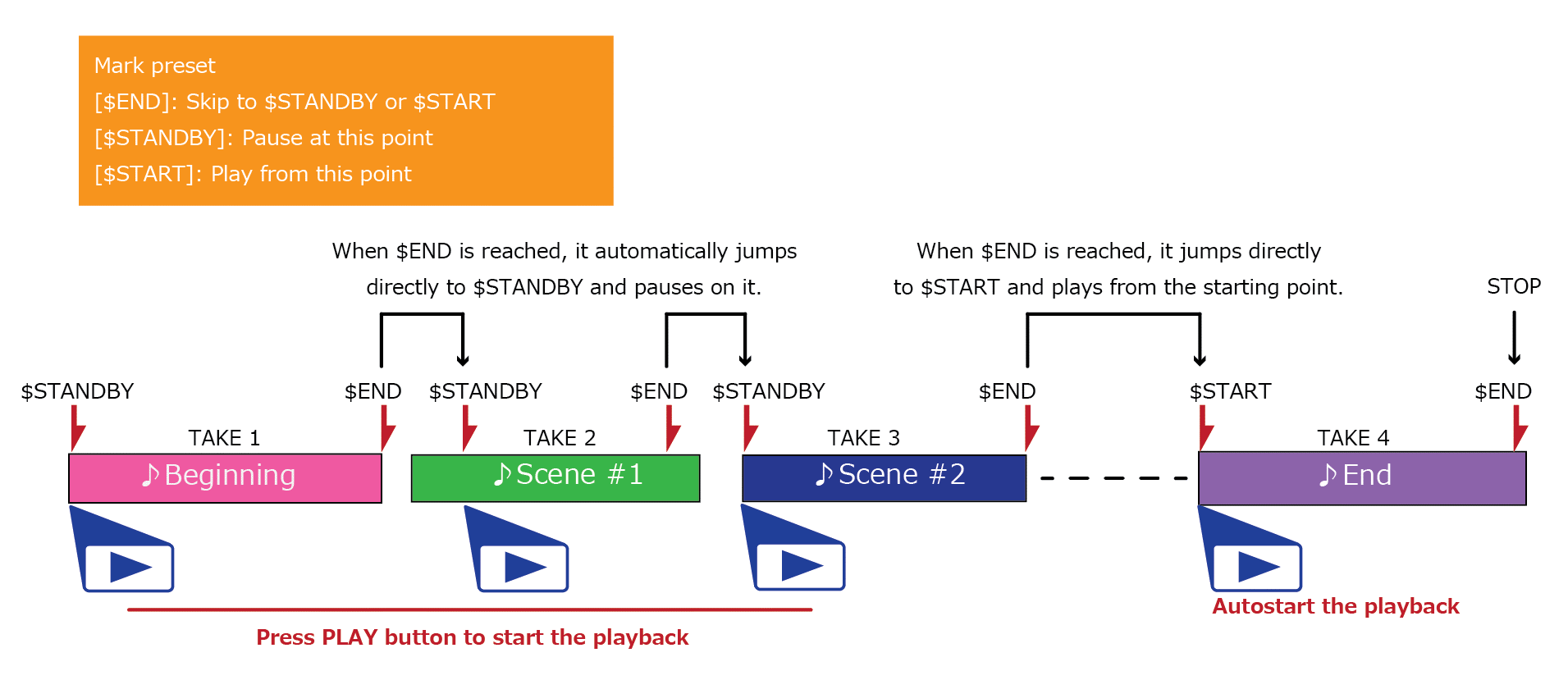
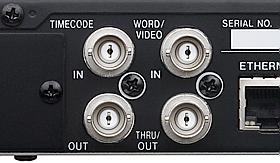
Using LTC (SMPTE timecode), the DA-6400 can be used as a timecode synchronization master device. The supported timecode frame rates are 24, 25, 29.97DF, 29.97NDF, 30DF and 30NDF.
The DA-6400 is capable of receiving timecode input from a ProTools system for backup recording with synchronized operation. Using serial/parallel control, you can control DA-6400 recording operations from ProTools.
With a studio/live system that supports MADI, you can use an IF-MA64/EX audio interface card that supports MADI thru output to include a DA-6400 between a mixing desk and ProTools (or another main recording system) allowing you to add a backup system easily. Also, in a system that supports Dante/AES67 and other interfaces, a compact DA-6400 can be used instead of a second complete system.
The main unit of the DA-6400 weighs 3.5 kg, enabling great mobility when used as a backup recorder – perfect for transport to a variety of locations. It can also be used in applications where recording/playback of rehearsal audio is required, or where a ‘virtual soundcheck’ is needed – as in live touring.
BWF is supported as a recording file format, and time information can be stored in files, making file searches and importing files into ProTools and other DAW software easy.
Note: Time information input through the TIMECODE IN can also be captured and written to files.
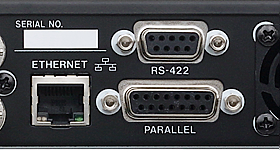
1000BASE-T gigabit LAN is supported, and the work protocol is FTP (File Transfer Protocol). Access is possible from any kind of system, including Windows, Macintosh and UNIX.
In addition to remote control and monitoring using the LAN function, external remote control using parallel and RS-422 serial communication interface (2P protocol) is supported.
With SNTP support, the DA-6400 can automatically update its internal clock at regular intervals over a network, so accurate time information can be maintained.
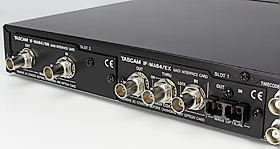
The DA-6400 has two rear audio interface slots. By adding interface cards (sold separately), flexible support for input and output options is possible. For example, signal conversion of Dante/AES67 input to MADI output is possible. In addition, one slot could use MADI/Dante to record 56 channels as the main, while the other slot could use AES/EBU to record 8 channels as the sub. Furthermore, by using two AES/EBU interface cards, the maximum number of simultaneous input and output channels can be increased to 32.

Audio interface cards can be swapped from their slots, enabling flexible support for different types. The lineup of interface cards includes solutions for MADI, Dante/AES67, AES/EBU, and a planned analogue output and AVB to complete the line. Support is available for the recording studio and live systems of major manufacturers, so you can choose interface cards according to the application requirements.
Note: When using two AES/EBU cards, a maximum of 32 inputs and outputs at 96 kHz/24-bit resolution is possible.
New functions with firmware version 2.00
New functions with firmware version 2.10
| General | ||
|---|---|---|
| Recording media | SSD/HDD | |
| File system | FAT32 | |
| File format | BWF format (wav extension) | |
| Number of channels | 64 channels maximum (44.1/48kHz sampling frequency) 32 channels maximum (88.2/96kHz sampling frequency) |
|
| Quantization bit depth | 16/24-bit | |
| Sampling frequencies | 44.1 kHz, 48 kHz, 88.2 kHz or 96 kHz | |
| Clock references | INTERNAL, WORD IN, VIDEO IN, SLOT1 IN, SLOT2 IN | |
| Timecode frames | 23.976F, 24F, 25F, 29.97DF, 29.97NDF, 30DF, 30NDF | |
| Analogue output | ||
|---|---|---|
| Headphones output (PHONES) | 6.3-mm standard stereo jack | |
| Maximum output level | 45 mW + 45 mW or higher (THD+N 0.1 % or less, 32 Ω load) |
|
| Other inputs and outputs | ||
|---|---|---|
| USB port | USB 2.0 A type | |
| Protocol | USB 2.0 Hi Speed (480 Mbps) | |
| Timecode input (TIME CODE IN) | BNC | |
| Signal voltage amplitude | 0.5–5 Vpp | |
| Input impedance | 10 kΩ | |
| Format | SMPTE 12M-1999 compliant | |
| Timecode output (TIME CODE OUT) | BNC | |
| Signal voltage amplitude | 2 Vpp | |
| Output impedance | 600 Ω | |
| Format | SMPTE 12M-1999 compliant | |
| Word/video clock input (WORD/VIDEO IN) | BNC | |
| Signal voltage amplitude | 0.5–5 Vpp (WORD IN) 1 Vpp (VIDEO IN) |
|
| Input impedance | 75 Ω ±10% (termination resistance on) | |
| Input frequency (WORD) | 44.1 kHz, 48 kHz, 88.2 kHz, 96 kHz | |
| Input signal (VIDEO) | 24/25/29.97/30-frame (NTSC/PAL black burst, HDTV tri-Level) | |
| Word/video output/through (WORD/VIDEO THRU/OUT) | BNC (throughput for video signal only) | |
| Signal voltage amplitude | 5V TTL equivalent | |
| Output frequency (WORD) | 44.1 kHz, 48 kHz, 88.2 kHz, 96 kHz | |
| Network connector (ETHERNET) | RJ45 | |
| Compatible standards | 100BASE-TX, 1000BASE-T | |
| RS-422 connector | 9-pin D-sub (female, inch-standard) | |
| PARALLEL connector | 15-pin D-sub (female, inch-standard) | |
| Power supply and other specifications | ||
|---|---|---|
| Power requirements | AC 100-240 V, 50/60 Hz | |
| Power consumption | 21 W (with IF-MA64/EX installed) | |
| Dimensions (width × height × depth) | 483 mm × 45 mm × 305 mm | |
| Weight | DA-6400: 3.9 kg DA-6400dp: 4.0 kg (without I/O card or SSD/HDD case) |
|
| Operating temperature range | 0–40 °C | |
Design and specifications subject to change without notice.
| Titel | Type | Størrelse | Download |
|---|---|---|---|
| IF-DA64_multi_vB-1.pdf | 1.09MB | Download |